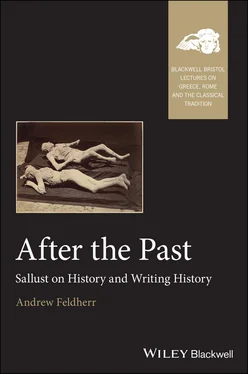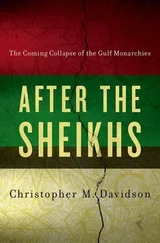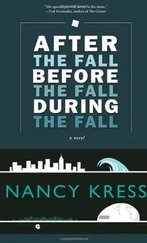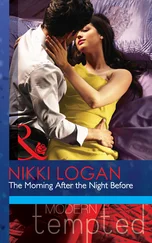1 ...6 7 8 10 11 12 ...20 Again, the final scene of Sallust’s first monograph provides a specific point of comparison. 3His account of the corpses of Catiline’s defeated army combines a physical description of where they lay and the front-facing wounds on their bodies with an effort to depict the emotional forces that animated Catiline—Sallust’s words transform the breath his body still expels into the ferocity of spirit he had possessed while alive:
Sed confecto proelio, tum vero cerneres quanta audacia quantaque animi vis fuisset in exercitu Catilinae. nam fere quem quisque vivos pugnando locum ceperat, eum amissa anima corpore tegebat. pauci autem, quos medios cohors praetoria disiecerat, paulo divorsius, sed omnes tamen advorsis volneribus conciderant. Catilina vero longe a suis inter hostium cadavera repertus est, paululum etiam spirans ferociamque animi quam habuerat vivos in voltu retinens. … neque tamen exercitus populi Romani laetam aut incruentam victoriam adeptus erat. nam strenuissumus quisque aut occiderat in proelio aut graviter volneratus discesserat. multi autem, qui e castris visundi aut spoliandi gratia processerant, volventes hostilia cadavera amicum alii, pars hospitem aut cognatum reperiebant; fuere item qui inimicos suos cognoscerent. ita varie per omnem exercitum laetitia maeror, luctus atque gaudia agitabantur . ( Cat . 61)
But when the battle was finished, then you might have beheld how much boldness and how much force of spirit had been present in the army of Catiline. For the very position which each while alive had fought to hold, his corpse was occupying even after death. A few in the center, whom the praetorian cohort had dislodged, lay at some distance, but all had fallen with wounds facing forward. Catiline himself was discovered far from his own troops amid the bodies of the enemy, still breathing a little and retaining in his expression the ferocity of mind that he had in life. … Nor did the army of the Roman people win a joyous or bloodless victory; for all of the most active had either fallen in battle or left it gravely wounded. Many who had come forth from the camp to look or to despoil, upon turning over the enemy corpses, discovered either a friend or a former host or relation; there were also those who recognized their own personal enemies. So diversely throughout the whole army exaltation and grief, mourning and pleasure were being enacted.
But it is not just the image Sallust represents that recalls the subject of the photograph. His narrative moves out from the corpses themselves to end with a view of the spectators coming out to see and take spoils from these bodies, and with an effort to evoke the emotions that “were being enacted” among the survivors as before he had done with Catiline. There is a big difference between looking at the image of an image of a 2000-year-old corpse in a museum on another continent and finding the real thing on a battlefield. But by making the last event in his narrative also the first event in its reception, Sallust highlights the layers of temporal and narrative distance between his reader and the actual scene. These layers can suggest separation, the 20 years from what we call 63 BCE to 43 and the distinction between a book and a body, or they can point to the stages that connect times and audiences. And to imagine an original audience for Sommer’s photograph brings a more immediate connection for us as well. As the nineteenth-century viewer was likely more aware than we, photography was a physical process only possible in the direct presence of what it depicts. The man and woman in the image left a material trace of remarkable intimacy on the volcanic matter that killed them. The gesso mold can only be made by putting the plaster into contact with that substance. The photograph can only be made by a long exposure to the mold. And one important use of these images was as souvenirs, which travelers could take back with them from their visit to the site. From this perspective, these inescapably modern images seem less depictions of antiquity than direct traces of antiquity. So too in the case of the Sallustian narrative, the distance that makes historiographic representation possible competes with an impression that the narrative itself is produced by the events it describes. His history becomes a fragment of the past, not so much removed from time as embedded in a process of transformation that can be traced within time.
This final effect of Sallust’s narrative, where the past at once recedes from and approaches the historian’s audience through a recognition of the text’s participation in time, provides my own starting point for interpreting his work. It is also the point of my title, “After the Past,” which intends to capture the same tension between distance and contiguity linking now and then. The complexity of Sallust’s positioning his audience in time can be first described through the tools of narratology, as in Jonas Grethlein’s holistic interpretation of all ancient historiography, informed by the modern struggle between what he calls teleology and experience as goals for historiographic representation. Teleological narratives lay emphasis on the hindsight available to both author and reader. Such depictions fit events into a larger story whose ending point lies beyond what any of the figures in the narrative can know and so inevitably separate the perspective generated by the narrative and those of the actors within it. By foregoing an effort to explain events, however, historians can much more directly reproduce the experience of the past. 4
Grethlein’s demonstration of how a historical narrative generates this division in points of view, for example, through effects like counterfactuals, which construct a future in the past different from how the reader knows things will always turn out eventually, leads him to quite surprising re-evaluations of the ancient historians. Yet while narratology offers an excellent and precise tool for describing these effects, it does not on its own suffice for explaining them. Narratology recognizes, indeed practically develops from the recognition, that descriptions of internal spectators or focalizers refract representations in the ways I have been discussing, but such descriptions also do something more. They draw attention to the very process of spectation and response and, by embedding it within their own narrative, interpret it. And so starting from this very up-to-date—I am tempted to say photographic—account of what Sallust does I want to ask more directly why he is doing it. How does his account of Roman history explain why it matters whether his work draws his reader closer to events or imposes distance? And what historical and cultural factors are likely to have made such choices meaningful for his contemporaries? In this chapter I suggest how three aspects of Sallust’s work can be connected through their mutual dependence upon a reader’s recognition of the narrative as a representation of the past or as a part of history. These aspects are, first, the larger temporal framework employed to locate events and to measure the distance between present and past; second, the consequences of such perceptions for the audience’s conception of their political present, whether they see themselves as part of the res publica or as outside, and after it. My final subject will be the historian’s own language and whether it can represent change or must be affected by it. Befitting my attempt to keep the historicity of Sallust’s writing before our eyes at the same time that we try to understand his own view of history, I will try to locate my interpretations within the time period in which Sallust wrote by making comparisons to the literary production of a precisely contemporary figure, Marcus Junius Brutus, born just one year after Sallust. And since his work is almost completely lost, no one will mistake my efforts at historicization as anything more than subjective prompts for reimagining the effects of Sallust’s writings.
Читать дальше












